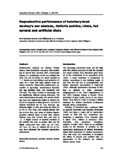Reproductive performance of hatchery-bred donkey's ear abalone, Haliotis asinina, Linne, fed natural and artificial diets
Share
抄録
Hatchery-bred donkey's ear abalone, Haliotis asinina, Linne broodstock were given diets consisting of natural food, seaweed (SW), Gracilariopsis bailinae, D1; combination of SW and artificial diet (AD), D2; and AD alone, D3. Equal numbers of 1 : 1 female and male abalone were stocked in 24 units, 60 L tanks with eight replicate tanks per dietary treatment. Reproductive performance, e.g. number of spawnings, instantaneous fecundity and egg hatching rates, was monitored over 270 days. The mean number of spawnings was not significantly different among treatments. The mean instantaneous fecundity and percent hatching rates were significantly higher in abalone fed D2 or D3 compared to those given D1. Survival of abalone broodstock fed D1 was, however, significantly higher at 88% than those fed either D2 or D3 at 75%. Fatty acid analysis showed that the n-3/n-6 fatty acid ratios of abalone hepatopancreas reflected those of their diets. Mature abalone ovary had n-3/n-6 fatty acid ratio of 1.3. A higher amount of essential nutrients in the artificial diet such as protein, lipid and the highly unsaturated fatty acids, e.g. 20 : 4n-6, 20 : 5n-3, 22 : 6n-3 in abalone fed D2 or D3, may have influenced the increased reproductive performance.
Suggested Citation
Bautista-Teruel, M. N., Millamena, O. M., & Fermin, A. C. (2001). Reproductive performance of hatchery-bred donkey's ear abalone, Haliotis asinina, Linne, fed natural and artificial diets. Aquaculture Research , 32(Suppl. 1), 249-254. https://doi.org/10.1046/j.1355-557x.2001.00022.x
主題
Taxonomic term
Collections
- AQD Journal Articles [1249]

